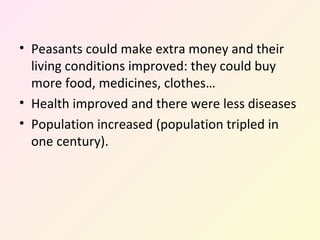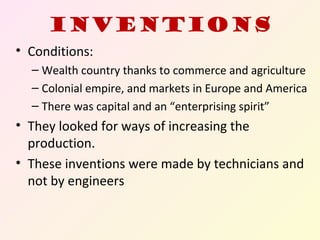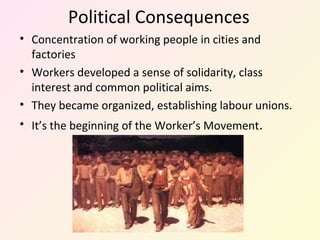Industrial revolution
- 2. • • • • • • • • INDEX Factors Domestic System Agricultural Revolution Enclosure Acts Inventions Conclusions Spread through Europe and America Changes in Society, Social Consequences, Political Consequences. • Second Industrial Revolution (second half 19th century)
- 3. Factors (It happened thanks to): • Accumulation of capital during the 18th from: – Trade – Agriculture (agricultural revolution: methods of cultivation and stock raising were improved) • Parliamentary democracy (gave the bourgeoise political power and influence) • Enclosure movement (Enclosure Acts) • Natural resources of coal and iron • New Inventions • Population Growth • Entrepreneurial Mentality
- 4. Domestic System • It was a production system spread in the countryside in almost all Europe in the 18th : – Great Britain, France, The Netherlands, north of Italy, some German States. 1. Merchants gave to workers raw materials (cotton or wool) 2. Workers (usually peasants)made textiles using spinning wheels and looms 3. Merchants came back and picked the manufactured goods.
- 6. • Peasants could make extra money and their living conditions improved: they could buy more food, medicines, clothes… • Health improved and there were less diseases • Population increased (population tripled in one century).
- 7. Agricultural Revolution Changes that took place during the 18th century and increased the production of crops: • Big landowners enclosed their lands. • New machines (Jethro Tull) • Use of different crops in a rotation system. This helped to fertilize the land (forage crops) • Small landowners and peasants couldn’t afford this new inventions or to enclosure the lands. They had to sell their lands and they moved to the towns to find work.
- 8. Jethro Tull
- 9. Enclosure Acts • They were made by the British Parliament controlled by big landowners. • Landowners were allowed to fence their lands and to stop renting it to local villagers. • Landowners started to invest in agriculture • Successful farming: – Extra money – Invested in new businesses – New industries
- 10. Social Consequences • Many peasants were forced to leave their lands and they moved to the cities. • Poverty and begging increased • Sever laws against crime and begging Bloody Code (1450-1850) – 222 offences carried death penalty: pickpocket, stealing more than 5 shillings, writing threatening letters… • Charles Dickens condemned this problems in his novel: “Oliver Twist”
- 11. Other Consequences • It raised the productivity of land and of farm labour (more cattle and more crops) • The food supply was increased while a smaller percentage of the population was needed to produce it. • Labour war released for other pursuits
- 12. Inventions • Conditions: – Wealth country thanks to commerce and agriculture – Colonial empire, and markets in Europe and America – There was capital and an “enterprising spirit” • They looked for ways of increasing the production. • These inventions were made by technicians and not by engineers
- 13. • Two kinds of inventions – Spinning inventions: they make the thread – Weaving inventions: they make the cloth. • 1733: John Kay, Fly Shuttle (lanzadera volante). Weaving invention
- 14. • 1733: Hargreaves, Spinning Jenny (spinning invention)
- 15. • 1769: Richard Arkwright, Water frame. (Spinning invention)
- 16. • 1763: James Watt: Steam engine • 1829: Liverpool-Manchester Railway • 1840’s: the era of railroad construction was under way
- 17. Conclusions • The early phase of the industrial revolution in Great Britain took place in the textiles industry, with some developments in the exploitation of iron and coal. • Factory system (this new system is created) • New banking techniques: – Corporations – Partnerships – Credit – Stock companies
- 18. The spread through Europe • The industrial revolution soon spread to other areas – France – Belgium – German States – United States of America
- 20. Changes in Society • Changes in social classes • New society based on money, not on estates (by birth) – Upper class: factory owners, landowners – Middle class: managers, doctors, lawyers, engineers… – Working class
- 21. Social Consequences • The new urban agglomerations were sad places blackened with the fumes • Entire families lived in single rooms and family life tended to disintegrate • Wages were very low (unskilled job and a lot of supply) • Children and women worked for less money. • Hours in the factories were long (14 hours per day)
- 22. Political Consequences • Concentration of working people in cities and factories • Workers developed a sense of solidarity, class interest and common political aims. • They became organized, establishing labour unions. • It’s the beginning of the Worker’s Movement.
- 23. The 2nd Industrial Revolution (1870) • New power sources: Oil (petrol) and Electricity • Higher demand of steel: trains, railways, cars, ships, iron buildings… • Growth of the Banking System and Stock Markets (bolsa): Era of High Capitalism • New industrialised powers: Germany and USA • First Monopolies (Standard Oil Co.) • New Industries: Chemical Industry, Oil Industry, Steel Industry
- 24. Inventions Light Bulb of Thomas Edison, 1879. Telegraph of Morse, 1840 Radio of Marconi, 1896 (or Tesla???) Telephone of Graham Bell, 1876 (or A. First automobile fueled by gas, 1885. The first flight, 1901























